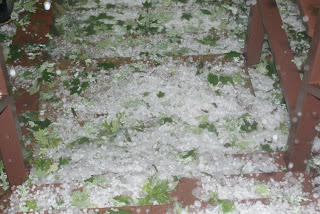It seems to be a sign of the times; everywhere you look someone has an idea for "frugal" this or "budget" that. I've always thought of myself as frugal; I'm wearing a watch I received as a school band award in high school, I have Birkenstocks older than my firstborn son and I just threw away a laundry basket that was my stepfather's before he married my mom sometime in the 1970's. (The cracks that had developed in it were finally pinching the fingers way too much.)
While I have been drawn to books on saving money, cutting costs, and living simply, I often find that there's just not so much I can learn. I can't cut out my Starbucks habit because I don't drink coffee. But I have been drawn to those kinds of books & websites because I have been in search of some magical way to attain nirvana - The Land. Mortgage-free lifestyle. Time.... the list goes on.
Just like everyone else we are starting to feel the pinch of this economy. Friends are losing jobs and we may not be far behind. As the reality of the situation that we are all in starts to be felt closer to home, I'm really glad that we have been working on ways of saving money every month. If our income remains the same, it will allow us to put a little money in the bank; if it goes down, well then maybe it will help us get by while keeping our house or at helping us avoid digging ourselves a very deep hole.
Over the last few months we have drastically changed our food buying habits. I thought we were frugal before; and sometimes we were. We ate good food, often seasonal food, and often from scratch. Except when we didn't. Like when we got home late and found it all too easy to call Papa John's. Or when it was easier to stop for Chinese carryout on the way home. Or when we looked in the cabinet and saw lots of good food but were too tired and hungry to figure out what to do with it.
In the course of my usual quest for money-saving, simple living resources I rediscovered the website whose name scares my children, the
Hillbilly Housewife. I promise there's nothing shocking there even if the name is a little scary. The site has two meal plans for either a low cost week of meals or an extremely low cost week of meals. Being brave but only a little bit, we decided to try the
$70 meal plan and see if we could learn anything about living a little lower on the hog.
I started by rediscovering
Aldi, the no frills, bag your own groceries store that has the bad rap as being just for poor people. In spite of the fact that a lot more of us might BE poor people soon, I found that for basic ingredients, Aldi was full of many money saving items.
When I tried the $70 menu I also rediscovered another concept that I had gotten away from--sticking to the list! It was really hard that first time to walk by the chips, snacks, and packaged things like granola bars. My mind said, "But they're so inexpensive, I could just get a few anway." But I stuck to my guns & stuck to the list. My total was more like $80-something with the increased prices over the last year but all in all I thought it was pretty good. Our family had been spending close to $200/week on groceries and that's not even counting eating out. But could we really stick to it and do it?
What I discovered was that there is a LOT more food in that menu than we usually use. Since most of us are gone during the day I rarely cooked the lunches. Brent and I took leftovers to work with us and we ate well and heartily. I even discovered that the salmon patties were pretty tasty. For someone who doesn't like fish this was a revelation. About a week into this experiment my son said, "We've been eating some REALLY good food lately!" Yes, he really said that!
Since that first week on the $70 menu I have continued to make the
Perfect Iced Tea every few days. I rarely bought soda before but I just don't buy it at all now. I didn't know I liked iced tea until I tried this. And I have made her
Biscuits with amazing succes more than once! I have never ever been satisfied with any home made biscuits of my creation before; but these seem to work every time.
What I learned that week was that I already knew how to be a wise cook; but I had forgotten the art of menu planning and sticking to the list. Next time I'll share more about our specific "system" and how it's going for us. Also news about another money saving food find and how we are fitting it into the "system" and eating well while saving money!
 We had the good fortune of trading some of our pork for beef that friends of ours, Linda and Rick, had recently purchased from an area organic farm. We offered to trade more pork for some of the apple cider they made, when they said there were plenty more apples to pick! So, with our three children, and a few friends of Linda we all went and picked more apples two Sunday's ago. I do not ever recall being able to pick apples this late in Indiana. The trees we picked from were dwarf apple trees that were easy to reach. Some of the trees were absolutely loaded with amazing fruit. The abundance and goodness was almost mind altering, as I ran from variety to variety tasting the fruit. In less than one hour our family alone had picked more than 200 pounds of apples. I felt like this was a little bit of Eden that I was experiencing.
We had the good fortune of trading some of our pork for beef that friends of ours, Linda and Rick, had recently purchased from an area organic farm. We offered to trade more pork for some of the apple cider they made, when they said there were plenty more apples to pick! So, with our three children, and a few friends of Linda we all went and picked more apples two Sunday's ago. I do not ever recall being able to pick apples this late in Indiana. The trees we picked from were dwarf apple trees that were easy to reach. Some of the trees were absolutely loaded with amazing fruit. The abundance and goodness was almost mind altering, as I ran from variety to variety tasting the fruit. In less than one hour our family alone had picked more than 200 pounds of apples. I felt like this was a little bit of Eden that I was experiencing.


















 We've been working on a variety of gardens and ideas for this year. We began by sprucing up the hillside area behind our home with wave petunia's to spread out and co-mingle with the native flowers and shade perennials we've planted the past few years.
We've been working on a variety of gardens and ideas for this year. We began by sprucing up the hillside area behind our home with wave petunia's to spread out and co-mingle with the native flowers and shade perennials we've planted the past few years. 
 I started by removing topsoil from an 3 x 12 area where I had established native prairie perennials the previous 4 years. I then used a pitch fork to gently open up and aerate the subsoil. I then placed partially rotted sticks, then a layer of partially composted chicken manure from our hens, then a layer of partially composted wood chips from the electric company had dumped the year before, then a layer of nicely composted dead wood that had turned to soil from a large pile of dead branches and wood I piled next to the forest four years ago. I did another layer of each of these items, then Beth and I used some old shelving boards and some redwood 2x4 from a dismantled deck that were here when we moved in for the sides of the bed.
I started by removing topsoil from an 3 x 12 area where I had established native prairie perennials the previous 4 years. I then used a pitch fork to gently open up and aerate the subsoil. I then placed partially rotted sticks, then a layer of partially composted chicken manure from our hens, then a layer of partially composted wood chips from the electric company had dumped the year before, then a layer of nicely composted dead wood that had turned to soil from a large pile of dead branches and wood I piled next to the forest four years ago. I did another layer of each of these items, then Beth and I used some old shelving boards and some redwood 2x4 from a dismantled deck that were here when we moved in for the sides of the bed.  We shoveled on the topsoil, an wow....our first ever raised bed. Now we need to plant it with a variety of garden veges and see what happens!
We shoveled on the topsoil, an wow....our first ever raised bed. Now we need to plant it with a variety of garden veges and see what happens!











